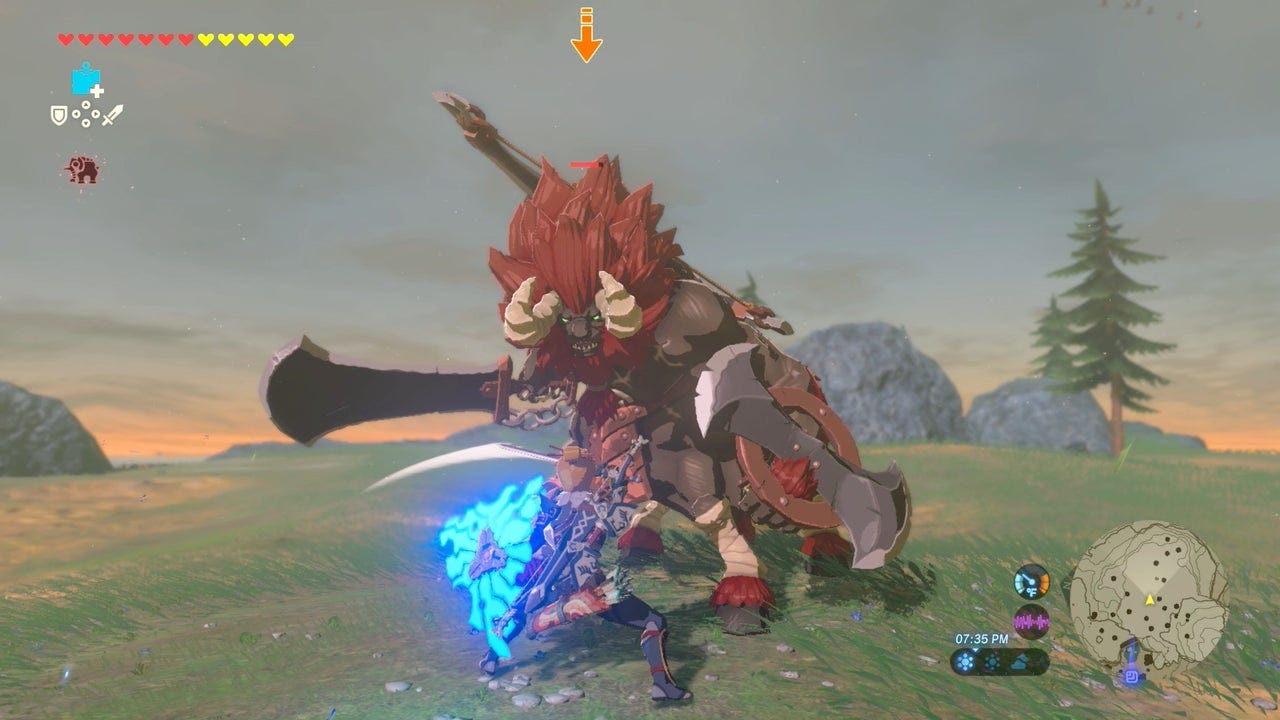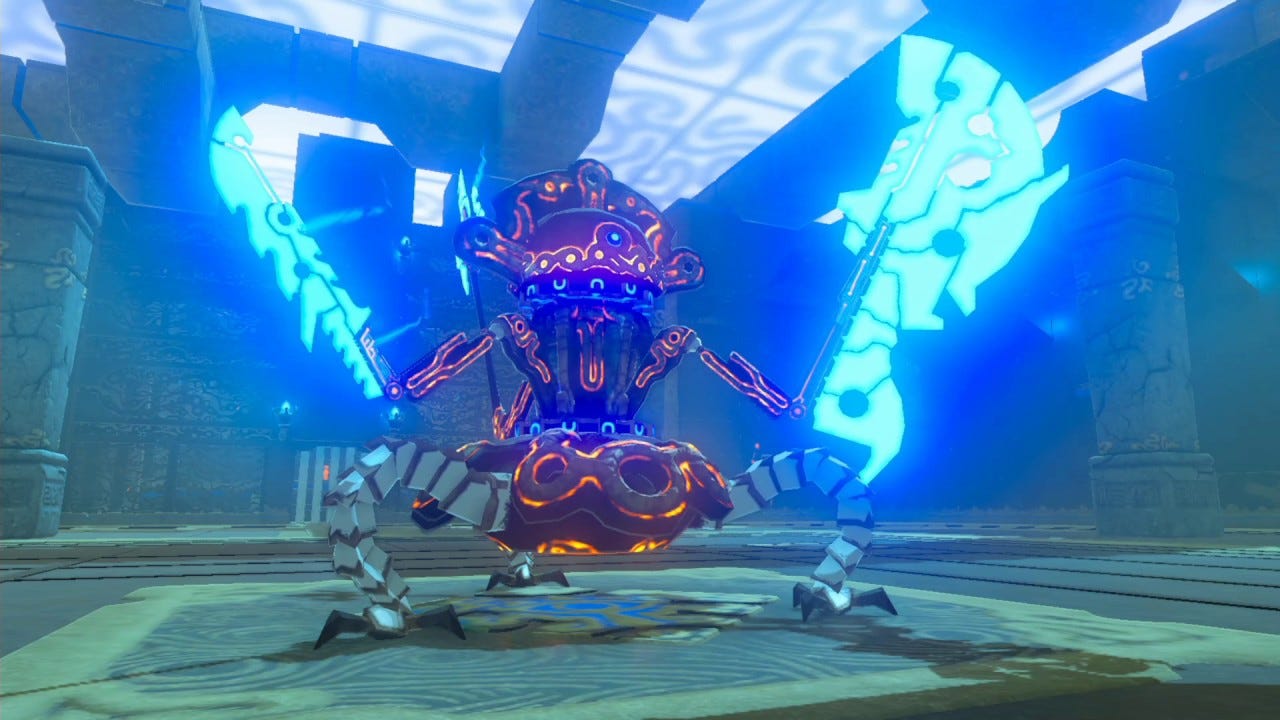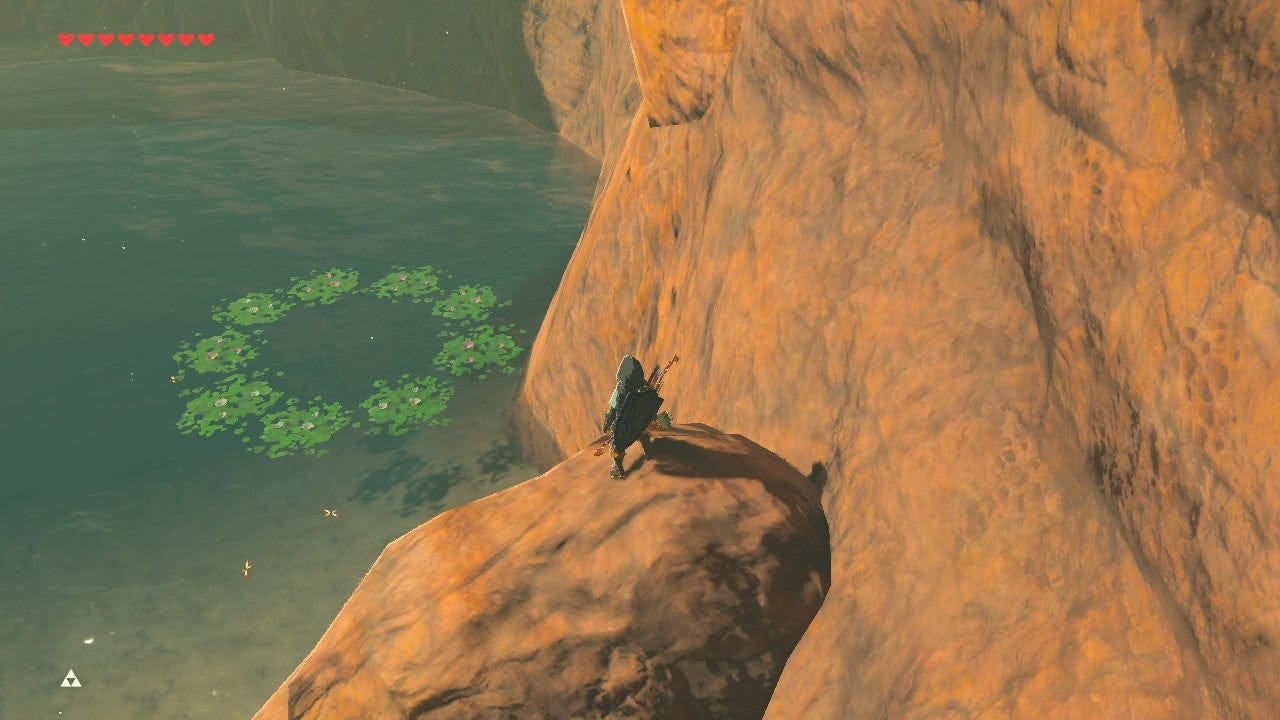So I finished Breath of the Wild last week.
Of course, like almost any game (certainly any recent game), crossing the finish line ended up being somewhat subjective. What brought my playthrough to a close and what contributed to a feeling of finality… those details were coalescing more or less the whole time, neatly tied off by defeating Calamity Ganon.
So now we’re in the postgame. A lot of games feature this period of play, where you’ve concluded the story or defeated a final boss, but are still free to roam and revisit content that you either missed or left unresolved. Optional challenges frequently await players in the postgame as well - perhaps the expected hidden superbosses, or levels/areas demanding the fullest and most precise use of the platforming controls, or the most cerebral puzzles. In essence: you’ve beaten the game but there are hidden peaks to scale if you love it. But if you merely enjoyed the game, you still feel that you had a complete experience. You’re able to ‘naturally’ move on.
There’s a whole tangent here about compulsive competionism in games, which quickly blurs discussions of game design with a spectrum of player personalities. Even games that have no proper ‘postgame,’ as it is usually understood, can be put under a completionist microscope. Players can and do impose their own parameters and invent their own challenges… and indeed, it’s worth remembering that almost every form of tracking and counting in 21st-century games originates as a way to tap into cultures players used to create on their own.
“Postgame” leads us into philosophical territory pretty quickly, if we’re so inclined.
Here, though, I’ll stay within the more typical confines of the term. I beat the game. I saw the credits. The game put a little star on my file (how quaint). But I’m still roaming Hyrule and there are still a handful of bedrock progression categories or content types: sidequests, shrines, and (to a much lesser extent) Korok seeds. These all represent things to discover and do, and everyone who plays Breath of the Wild will defeat Calamity Ganon with a different combination of completed quests/shrines/seeds. Raw completionism pulls a lot of other things into the vortex: did you acquire and fully upgrade all armor sets, or even, did you max out your inventory quantities. But we’ll set those extra layers aside.
Today I want to talk about an inescapable feeling I have: this is one of the weirdest postgames I’ve ever encountered.
Why?
I think it comes down to the fact that so much remains undone, but Link himself feels “finished,” and the world feels largely explored. It’s a dissonant feeling.
I defeated Calamity Ganon with slightly over half of the shrines undiscovered (I’ve since edged just over 50%). Experience gives me the overwhelming expectation that these shrines represent juicy brain-teasing puzzles, underexplored landscapes, and tantalizing new advantages for Link. That’s 30+ years of gaming whispering in my ear. But the reality in front of me seems to say something else.
I’ve been “most places” in Breath of the Wild. By the nature of the map, I haven’t walked every path or surveyed my surroundings from every vantage point. But that feels like a very academic point to make. When an ‘open world’ is this size, you take in your surroundings as you go and some of that boils down to draw distance. I’ve ‘experienced’ Death Mountain but I have not seen it through the eyes of a survey team or a cartographer. It probably holds a secret here or there that I missed. But the sheer scale of the game means I don’t have an intuitive sense of that or a strategy for uncovering more. Instead I’m left with an overall feeling that I’ve been there, spent time there, explored, discovered, etc. I don’t feel ‘let down’ even though I know my knowledge is ‘fuzzy.’
This goes a long way toward taking deeper exploration off the table in the postgame. I can identify some ‘pockets’ of the map I skirted around initially (for example, last night I was thoroughly exploring the tall islands on the NE Coastline). But there’s a nagging feeling of “I’ve been everywhere.”
So then, consider the rewards for finding more shrines. In batches of four, I can improve Link’s health or stamina. Of the two, more Stamina does provide a minor convenience - all the fast-climbing, gliding, sprinting, etc. But I’ve already got quite a generous stamina-wheel paired with functionally-endless Endura-cooking. There literally does not exist a ‘demand’ on Link’s stamina anywhere in Hyrule that would make me excited to increase my ‘supply.’ Even as a matter of swagger. For health the situation tilts further toward this feeling of being moot. Functionally, I have infinite healing, infinite revival (faeries & Mipha’s Grace), easy access to ‘extra’ hearts, and most importantly, the fully upgraded Ancient Armor set, which seems to mean that just about everything in Hyrule deals less than a single heart of damage at a time. Even being damaged at all often requires being in a hurry, being nonchalant, treating enemies as a kind of in-passing incidental nuisance. Not always, of course. I’m just pointing out that a big portion of the ‘threat’ late in Breath of the Wild begins to depend on how seriously you are taking enemies you’ve decided to defeat. Which, if you zoom out, also highlights that most enemies are easily ignored.
And lastly, with regard to shrines and post-game motivation, there’s just the fun and interest of doing them - their quality as individual puzzles, little enigmas to work out with Link’s runes. Gameplay-wise, shrines in Breath of the Wild almost remind me of individual rooms in Portal or Portal 2. Partly because they have the same sterile/abstract aesthetic. But they don’t have that level of depth, and don’t produce the cerebral ‘highs’ of basically any above-average dungeon in any prior Zelda title. By design, shrines here give you a ‘micro-dose’ of satisfaction, a small bite rather than a full meal. This sort of ‘exploded’ game design seems to define and encompass not only Breath of the Wild but also Super Mario Odyssey. But it’s not really what I want in a postgame. Metaphorically, at this point I’m looking for breakneck speed… but shrines seem to just hum along in first or second gear. 50 hours in, they remain what they were 5 hours in. They’re also hit and miss by type: any “Test of Strength” is an afterthought, over before it begins, and any tilt-controlled puzzles are an eyeroll.
So in terms of engagement and meaty gameplay, the shrines aren’t bad but it’s hard to see how they fit into any postgame sprint or crescendo. They’re brief, inconsistent, and above all they hold back and all operate on more or less the same level.
There’s a voice in my head saying that, in the postgame, Breath of the Wild simply collapses in on itself. The game is excellent for a long time, and excels in a lot of ways. Today’s post is not meant to take that away from the game or invalidate all of the acclaim and analysis I’ve written about it from other angles. But it’s an extraordinarily front-loaded game. And that, for better or worse, feels like a hallmark of the more corporate AAA games that Nintendo clearly meant to upstage.
Korok Seeds are even sillier, but I’ll mention them briefly. 40-50 Korok seeds (in a game with 900) is enough for anyone to unlock plenty of extra inventory slots, and past that, every additional slot is pretty meaningless. I would call this on-paper completionism - the game giving you a high-five. Which is harmless enough, but the idea here seems to be: everyone’s path through the game is different, and since the gameworld is so absurdly huge, we need there to be tons and tons of Koroks so that everybody encounters 40-50 incidentally. Seen that way, it works just fine. But are the individual koroks that ‘interesting?’ Once you’ve played a bit, the korok experience becomes “oh there’s probably a korok here.” No real thought required, not really a puzzle, just a little secret. A little micro-dose. I enjoy finding secrets in games, but the idea of actively scouring the postgame for koroks feels almost totally meaningless. They don’t make Link more formidable, and once you’ve found several, you feel like each new one is a variation on something you’ve already seen.
It would be one thing if only some of the above were true. For big games like this that set you loose after defeating a final boss, there’s no ‘one way’ to configure a postgame, no rules, exactly. But Breath of the Wild sends a weird message. That message seems to be: ‘we wanted most players to be at their peak when they concluded the story.’ Or, we wanted the incredible variation of the first ‘half’ of the content (measuring by shrines) to all lead to one destination.
(There’s a separate conversation to be had about how ‘early’ you can beat Breath of the Wild, but again, the adds depth/challenge/texture to the early game)
I imagine that most developers know that hardcore, compulsive, innate-personality completionists will tackle games like that almost regardless of the design. Which is fine. More power to those players. Still, I can’t quite shake the feeling that Breath of the Wild just gives up on itself, just removes the common postgame motivations as soon as you arrive. No real reward for Link, extremely diluted exploration for pockets of undiscovered space, gameplay that is still operating on the same level as the early game.
I can’t decide how much this bothers me or undercuts the overall experience. Perhaps because I’m genuinely not sure I can recall a similar postgame cliff.





Odd. I've played quite a number of games recently where the Post-Game is at least half, and some times more than half, the experience. Pokemon and Monster Hunter are both famous for it. I can't think of another instance where a game offers a post-game with so little incentive to play.
My big problem is always feeling stuck between wanting to see all the 'post-game' stuff, to feel like I've gotten the complete experience, and wanting to move on to the next game!